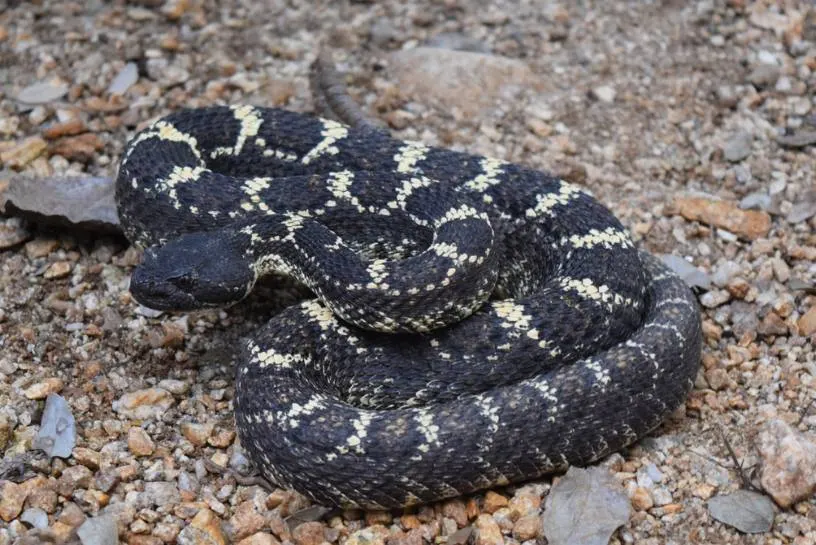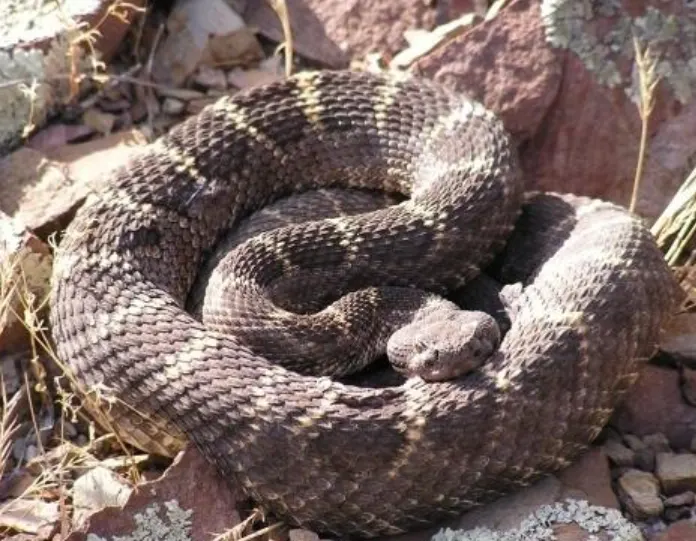In the rugged landscapes of central Arizona and western New Mexico, amidst the pine forests and rocky outcrops, resides a creature both feared and revered—the Arizona Black Rattlesnake (Crotalus cerberus). Known for its striking appearance and intriguing social habits, this species of rattlesnake offers a fascinating glimpse into the world of reptilian adaptation and behavior.
Table of Contents
Physical Characteristics and Habitat
The Arizona Black Rattlesnake is a medium-sized snake, typically ranging between two to four feet in length. Juveniles often exhibit lighter base colors with distinct dark patterns along their bodies, providing camouflage among leaf litter and rocky terrain. As they mature, their coloration darkens, blending into the forest floor with shades of brown or almost black. This adaptive color change helps them remain inconspicuous while they lie in wait for prey.
- Coloration Adaptation: Their ability to change color from juvenile to adult helps them blend into their forest habitat effectively.
- Size and Appearance: Medium-sized, with a spade-shaped head and a heavy-bodied build, ideal for their forested, rocky environments.

Social Dynamics and Unique Behaviors
One of the most distinctive aspects of the Arizona Black Rattlesnake is its semi-social behavior, a trait uncommon among rattlesnake species. Unlike solitary individuals, these snakes have been observed exhibiting communal behaviors, particularly during hibernation. They often share dens with other rattlesnakes, including females and their young, marking a departure from the typical solitary nature of most reptiles.
- Communal Living: They share dens and exhibit social behaviors such as communal parenting and sharing basking locations.
- Parental Care: Females protect and nurture their young for extended periods after birth, enhancing survival rates.
Diet and Predatory Strategies
As carnivorous predators, Arizona Black Rattlesnakes primarily feed on small mammals such as rodents and rabbits, as well as lizards and occasionally birds. They rely on their ambush hunting technique, patiently waiting concealed in their preferred habitats until unsuspecting prey ventures within striking distance. Their venom, delivered through hollow fangs, immobilizes and begins digesting the prey, facilitating efficient consumption and energy acquisition.
- Ambush Predators: They wait patiently in leaf litter and rocky crevices for prey to pass by.
- Venomous Adaptation: Venom facilitates effective prey capture and digestion, critical for their survival.
Conservation and Human Interaction
Despite their venomous nature, Arizona Black Rattlesnakes are generally docile and avoid confrontation with humans whenever possible. Most encounters occur incidentally, as these snakes navigate their territories in search of food or suitable den sites. However, human activities such as habitat destruction, road mortality, and illegal collection for the pet trade pose significant threats to their populations.
- Conservation Challenges: Habitat destruction and road mortality threaten their survival.
- Conservation Efforts: Efforts include habitat preservation, education, and responsible land management practices.
Research and Scientific Insights
Scientific research continues to unravel the mysteries surrounding the Arizona Black Rattlesnake. Studies focus on their ecological interactions, habitat preferences, reproductive biology, and venom composition, providing valuable insights into their role within the complex web of forest ecosystems. Ongoing field observations and conservation efforts are instrumental in expanding our knowledge and informing effective conservation strategies.
- Scientific Discoveries: Insights into social behaviors and ecological roles contribute to conservation efforts.
- Field Observations: Direct observations help understand habitat use and population dynamics.

7 interesting facts about the Arizona Black Rattlesnake
- Social Behavior: Unlike most rattlesnakes, Arizona Black Rattlesnakes exhibit semi-social behavior, sometimes sharing communal dens and basking sites with other individuals of their species.
- Color Changing Abilities: They possess the remarkable ability to change color, which is influenced by factors such as temperature and mood. This adaptability helps them regulate body temperature and camouflage.
- Maternal Care: Females display uncommon maternal behavior among snakes. They may remain with their young for up to two weeks after birth, providing protection and guidance before the neonates disperse.
- Distinctive Venom: Their venom, though potent, is primarily used for subduing prey rather than defense. Bites are rare and usually occur when humans accidentally step on or provoke them.
- Ecological Role: As top predators, Arizona Black Rattlesnakes play a crucial role in their ecosystem by controlling populations of small mammals like rodents, which helps maintain ecological balance.
- Unique Habitat Preferences: They inhabit montane forests at higher altitudes, preferring cooler, moister environments compared to many other rattlesnake species that typically dwell in arid or desert regions.
- Taxonomic History: Originally considered a subspecies of the Prairie Rattlesnake (Crotalus viridis), the Arizona Black Rattlesnake was later recognized as a distinct species due to genetic and ecological differences.
The Arizona Black Rattlesnake stands as a testament to the resilience and adaptability of wildlife in challenging environments. Through its unique coloration, social behaviors, and predatory strategies, this species exemplifies evolutionary success in the face of natural and anthropogenic pressures. As stewards of biodiversity, it is our responsibility to appreciate and protect these remarkable creatures, ensuring they continue to enrich our natural world for generations to come.
- Enchi Ball Python: A Unique and Stunning Morph of Python regius - March 27, 2025
- Emerald Tree Monitor: The Enigmatic Green Guardian of the Rainforest - March 26, 2025
- The Egyptian Cobra (Naja haje): A Fascinating Serpent - March 25, 2025
